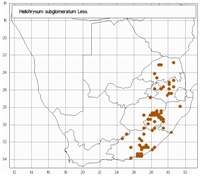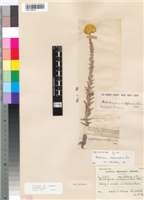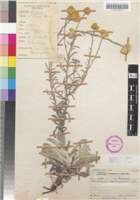Common names:
Kerriebos; -kruie (A)
Origin of name:
sub = hemi (half)glomeratus = clusters in round heads
Diagnostic characters:
Bright yellow bractsCompact inflorescences on short stalksHeads fused into umbrella structure, woolly belowRosette of numerous larger leaves from a woody rootstockLeaves silver-grey
Description:
Perennial herb, stock stout, crowned with one or several leaf rosettes, flowering stems several, lateral to each rosette, 80-600 mm long, often decumbent at the base or ascending, commonly simple, sometimes forking once or twice near the base, more rarely near the apex, densely leafy. Radical leaves up to 120 x 15 mm, but often less than half that, lingulate, oblong or elliptic, apex obtuse or subacute, base broad, clasping, both surfaces clothed in very close, silvery silky-felted indumentum, occasionally more woolly than silky; cauline leaves similar but smaller and decreasing rapidly in size upwards, spreading or more or less imbricate, enveloped in the same silvery, skin-like indumentum as the radical leaves and the stem. Heads homogamous, narrowly cylindric, 2.5-3.5 x 1.5-2 mm, very many in small corymbose clusters congested in a flattened spreading cymose corymb c. 20-40 mm across, the whole matted together below with closely interwoven wool. Involucral bracts in 3-4 series, subequal, loosely imbricate, outer brown or straw-coloured, inner tipped bright canary yellow, about equaling the flowers, not radiating, translucent. Receptacle shortly honeycombed. Flowers 4-13, yellow. Achenes 0.75 mm long, narrow, glabrous. Pappus bristles c. 5-7, delicate, tips shortly plumose, bases nude, not cohering.
Flowers from March to June.
Distribution:
Grows scattered in stony grassland or, in the Cape, in fynbos, or may form small mats over rock sheets. Ranges from Zimbabwe to Limpopo and Mpumalanga, where it is recorded from the E. highlands, the Waterberg, and the Highveld, to KwaZulu-Natal, where it is commoner along the Drakensberg than in the coastal districts, the mountainous NE. corner of the Free State, Lesotho, and the Eastern Cape, both in the mountains and along the coast, as far west as Uitenhage and Graaff-Reinet. Also recorded from Huila in Angola and the Okavango Valley in NE. Namibia.Grows scattered in stony grassland or, in the Cape, in fynbos, or may form small mats over rock sheets. Ranges from Zimbabwe to Limpopo and Mpumalanga, where it is recorded from the E. highlands, the Waterberg, and the Highveld, to KwaZulu-Natal, where it is commoner along the Drakensberg than in the coastal districts, the mountainous NE. corner of the Free State, Lesotho, and the Eastern Cape, both in the mountains and along the coast, as far west as Uitenhage and Graaff-Reinet. Also recorded from Huila in Angola and the Okavango Valley in NE. Namibia.
Savanna, Grassland and Thicket Biomes.
Taxonomy:
Literature:
Helichrysum subglomeratum Less., Syn. Comp. 283 (1832); DC., Prodr. 6: 186 (1838), excl. var. imbricatum DC.; Harv. in F.C. 3: 235 (1865); Moeser in Bot. Jb. 44: 249 (1910); Merxm., F.S.W.A. 139: 249 (1967); Hilliard, Compositae in Natal 156 (1977).
Type:
Lectotype: Cape, Krebs 146 (G-DC; S, isolecto.).
Synonym(s):
Gnaphalium subglomeratum (Less.) Sch. Bip. in Bot. Ztg 3: 171 (1845); Helichrysum subglomeratum var. lingulatum Harv. in F.C. 3: 236 (1865).
Vouchers:
Codd 2903 (NU; PRE); De Winter 4368 (PRE; WIND); Hilliard & Burtt 10031 (E; K; M; MO; NU; S): Wright 486 A (E; K; M; NH; NU; SRGH).


